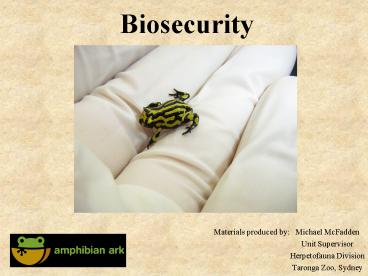Biosecurity - PowerPoint PPT Presentation
1 / 13
Title:
Biosecurity
Description:
Biosecurity Michael McFadden Unit Supervisor Herpetofauna Division Taronga Zoo, Sydney Materials produced by: Why do we need Quarantine? To prevent the transmission ... – PowerPoint PPT presentation
Number of Views:172
Avg rating:3.0/5.0
Title: Biosecurity
1
Biosecurity
Materials produced by
- Michael McFadden
- Unit Supervisor
- Herpetofauna Division
- Taronga Zoo, Sydney
2
Why do we need Quarantine?
- To prevent the transmission of pathogens and
disease amongst amphibians. - This includes
- From the wild into captivity,
- From captivity back into the wild, and
- Between specimens in captivity.
3
Assessing the Risk
- First, we must assess what are the greatest risk
factors. - Disease can be spread by what enters and what
leaves an enclosure. - Pathogens can be present on a new frog, on cage
furnishings, in the water or on the keeper
maintaining the cage.
4
What level of biosecurity is needed?
- Any species which may be used as part of a
reintroduction or release program should be
maintained with the strictest quarantine. - The level of quarantining in a collection between
species largely depends on the reason the species
is being held.
5
How do we implement effective biosecurity?
- Quarantining new specimens.
- Using strict protocol and barrier equipment and
working between specimens. - Facility or enclosure design.
- Quarantining equipment and wastewater exiting a
facility.
6
Quarantining of new specimens
- All new specimens should be quarantined and not
released until - Diagnostic tests for certain diseases return
negative results (I.e. Chytrid fungus). - The animals if feeding and not losing weight.
- No health problems have been detected.
- There have been no abnormal behaviours.
- The length of the quarantine period will vary, a
good starting point could be 60 days.
7
Quarantine Procedures
- Servicing amphibians of most significance before
any other animals. - Use barrier techniques entering a facility,
including - dedicated boots or foot baths,
- dedicated clothing (or showering upon exit) and
- using disposable gloves between animals and
enclosures.
8
Quarantine Facility
- Ideally, the quarantine facility should be a
separate building from the main collection. - It should have separate air conditioning systems
and wastewater outlets to minimise risk of
pathogen transfer. - Quarantine tools and equipment should never leave
the quarantine area. - Amphibians coming into or leaving quarantine
should do so on an all in all out basis.
9
The use of shipping containers as quarantined
amphibian facilities, as pioneered by the
Amphibian Research Centre, Australia
- Southern Corroboree Frogs, Taronga Zoo, Sydney
- Northern Corroboree Frogs, Tidbinbilla Nature
Reserve, Canberra
10
Enclosure design
- The design of an enclosure can add greatly to the
level of biosecurity. - Enclosures designed with minimal need for keeper
access automatically reduce the risk of keeper
error. - This can include automated sprayers, filtering
systems and funnel feeders if applicable.
11
Enclosure Design
- Enclosures should also be designed so that there
is - No water splashing between enclosures,
- No risk of backwash through the drainage,
12
Quarantining waste
- There is always a real possibility that the local
wild amphibian can be infected by diseases in the
captive collection too. - For this reason, every effort should be made to
protect the local amphibians and sterilise waste. - Wastewater leaving enclosures should be treated
and cage furnishing should be destroyed.
13
Quarantine applies to field work too!!!!
- Additional attention must be paid to ensure that
diseases are not spread by biologists in the
field. - Between sites If possible, shoes and vehicle
wheels should be cleaned and clothes should be
changed. - Between specimens always wear a new pair of
disposable gloves and sterilise equipment used on
the frogs.































